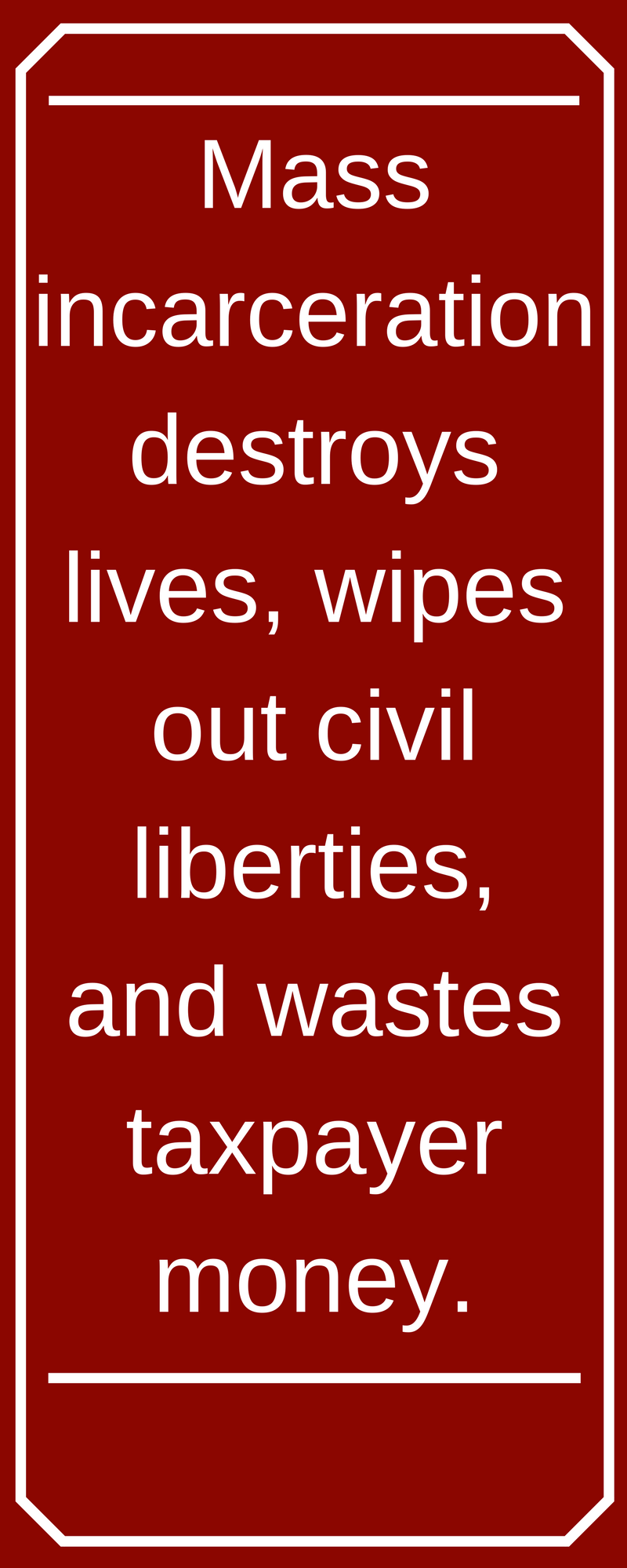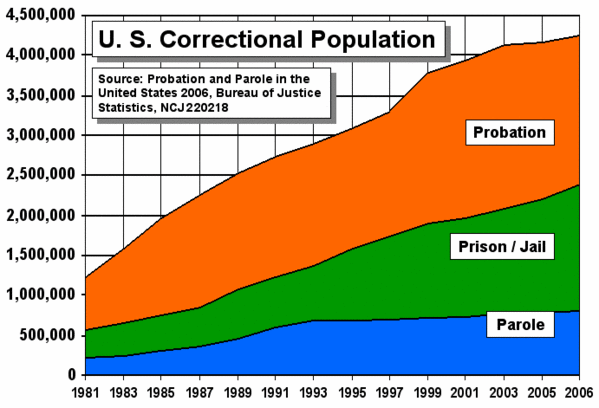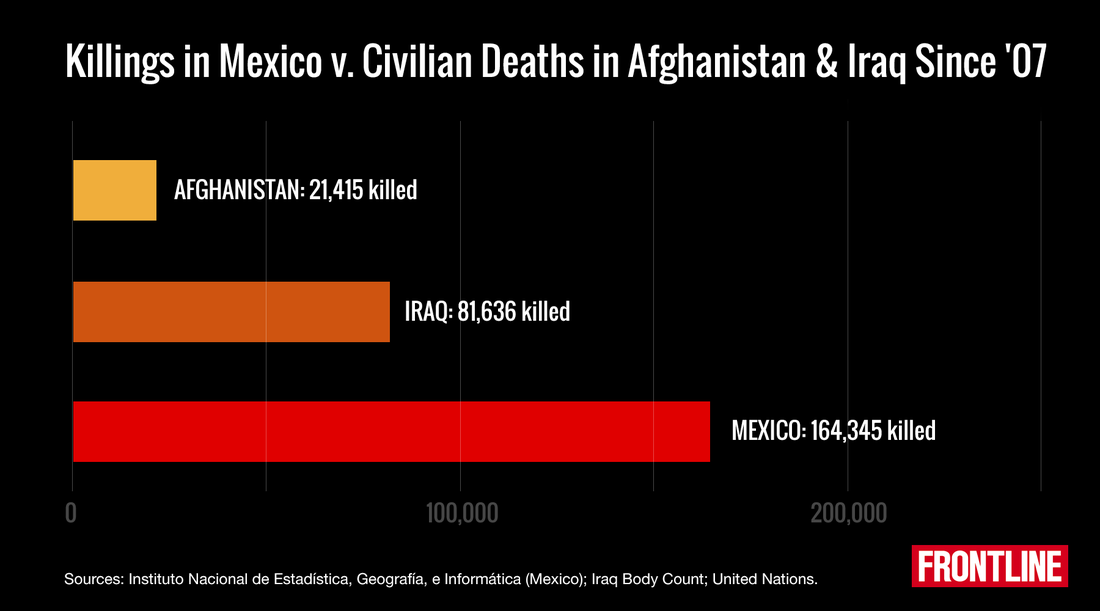Statistics: Drug War Facts
The Drug War Impacts Huge Numbers of People
One in every 31 adults in the U.S. is either incarcerated or on probation or parole. Pew Research study entitled 'One in 31, The Long Reach of American Corrections'
One in every 18 men in the U.S. is either incarcerated or on probation or parole. Pew Research study entitled 'One in 31, The Long Reach of American Corrections'
The U.S. has the highest percentage of population in jail anywhere in the world, comprising less than 5% of the world's population with 22% of the world's prisoners. NAACP Criminal Justice Fact Sheet, 2013 statistics
One out of every 100 American adults is currently incarcerated - in jail or prison. Pew Center on the States. (February 2008).

Incarceration for drug offenses has increased 12-fold from 40,000 in 1981 to nearly 500,000 by 2010. The New Jim Crow, Mass Incarceration in the Age of colorblindness, Michelle Alexander, c. 2010
There are more African American men in prison and in jail, or on probation or parole than were slaves before the start of the Civil War. The New Jim Crow, Mass Incarceration in the Age of colorblindness, Michelle Alexander, c. 2010
A black child born today is less likely to be raised by both parents than a black child born during slavery. Alexander, Michelle, Where Have All the Black Men Gone?, Huffington Post, April 2010, Updated May 2011
Over 1.6 million people will be arrested for drug law violations in 2017. Uniform Crime Reports, Federal Bureau of Investigation
Someone is arrested for violating a drug law every 19 seconds. Uniform Crime Reports, Federal Bureau of Investigation
85% of all drug arrests are for possession only. LEAP (Law Enforcement Action Partnership), a group of current and former police, prosecutors, judges, FBI/DEA agents, correctional officials, military officers and others who've been on the front lines of the War on Drugs.

The federal government estimates that 47 percent of the U.S. population above the age of 12 admits to using illegal drugs. U.S. Department of Health and Human Services. Substance Abuse and Mental Health Services Administration. (September 2010).
The War on Drugs has created huge increases in incarceration rates. Bureau of Justice Statistics, Department of Justice; the Wall St. Journal
There are at least 346,605 people serving sentences in state and federal prisons for drug possession or sales in the U.S. (including more than half the entire federal inmate population). U.S. Department of Justice. Bureau of Justice Statistics.
There were also 767,620 inmates held in local jails in the U.S. in 2009. U.S. Department of Justice. Bureau of Justice Statistics. (June 2010).
Based on a 2013 report, between 2001 and 2013, more than half of federal prisoners serving sentences of more than a year were convicted of drug offenses. 51% of all inmates in federal prisons were convicted of drug-related crimes. Carson, E. Ann. Prisoners In 2013. Washington, DC: US Dept of Justice Bureau of Justice Statistics
In 2002 (the most recent year offense data was collected), possessing or selling drugs was the most serious crime committed by a quarter of jail inmates. (An unknown number of additional persons are incarcerated for crimes that occur due to the currently illegal and unregulated nature of drug markets, such as property crimes used to pay for illegal drugs or violent disputes for control of the market). U.S. Department of Justice. Bureau of Justice Statistics. (July 2004)
In Washington, D.C. 3 out of every 4 young black men are expected to serve some time in prison. NAACP Criminal Justice Fact Sheet, 2013 statistics
The U.S. has a higher % of imprisoned minorities than any other country in the world. NAACP Criminal Justice Fact Sheet, 2013 statistics
In major cities across the country, 80% of young African Americans now have criminal records. NAACP Criminal Justice Fact Sheet, 2013 statistics
The U.S. has spent over a trillion dollars of taxpayer money on the War on Drugs since 1971 - not counting the impact of loss of productivity and costs related to those incarcerated or whose criminal records compromise career opportunities. Yet, despite all this expense, the U.S. is the number one nation in the world in illegal drug use. Investigation by the Washington Post
Legalizing drugs would save the U.S. about $41 billion ANNUALLY in just drug enforcement costs. Cato Institute study
Annual cost of U.S. Drug war is estimated at $70 billion by LEAP. LEAP (Law Enforcement Action Partnership), a group of current and former police, prosecutors, judges, FBI/DEA agents, correctional officials, military officers and others who've been on the front lines of the War on Drugs
Average annual cost of incarcerating an inmate for a year exceeds $30,000. Pew Research Center study
Over $2.5 billion has been taken from U.S. citizens without warrants or criminal charges since 2001 under civil forfeiture laws that allow local and state police to keep 80% of the proceeds with the rest shared with federal agencies. Investigation by the Washington Post
Financial Impact
The amount spent on the war on drugs just this year to date.
From 2001-2010, federal spending on drug enforcement strategies grew by 69.7 percent. During the same time period, spending on treatment and prevention grew by only 13.9 percent. U.S. Office of National Drug Control Policy. (February 2010).
Conservative estimates say that legalizing and regulating drugs could boost the U.S. economy by $88 billion a year in law enforcement savings and new tax revenue. Miron, Jeffrey. (September 2010). The Budgetary Impact of Ending Drug Prohibition.
Drug cartels wholesale earnings from illicit drug sales range from $13.6 billion to $49.4 billion annually. 2007 Report to Congress entitled 'Mexico's Drug Cartels'
10% of Mexico's economy is now built on drug proceeds. 2007 Report to Congress entitled 'Mexico's Drug Cartels'
While Mexican drug cartels traffic heavily in cocaine and methamphetamine, law enforcement officials estimate that 65 to 70 percent of their profits come from illegal marijuana sales, although it is inherently difficult to study illegal markets. U.S. Senate Judiciary Committee, Subcommittee on Crime and Drugs. (March 2009).
Public Opinion
Three out of four American voters say the “war on drugs” is a failure. Zogby International. (October 2008).
In a survey by the National Association of Chiefs of Police, 82 percent of police chiefs and sheriffs said that the War on Drugs has not been successful in reducing drug use. National Association of Chiefs of Police. (2005).
Opportunity Costs
In the U.S.’s overburdened criminal justice system, nearly four of ten murders, six of ten rapes and nine of ten burglaries go unsolved. U.S. Department of Justice, Federal Bureau of Investigation. (September 2010)
In 2013, 22.7 million persons aged 12 or older (or 8.6% of that group) needed treatment for an illicit drug or alcohol use problem. Of these, 2.5 million received treatment at a specialty facility. Only 10.9 percent of those who needed treatment received it. 20.2 million persons (7.7 percent of the population aged 12 or older) needed treatment for an illicit drug or alcohol use problem but did not receive treatment at a specialty facility in 2013. Substance Abuse and Mental Health Services Administration, Results from the 2013 National Survey on Drug Use and Health
Devastating Results
Over 200,000 students have lost federal financial aid eligibility because of a drug conviction. Students for a Sensible Drug Policy
More than 50 people die of unintentional drug overdoses in the U.S. every day. U.S. Department of Health and Human Services. Centers for Disease Control and Prevention. (March 2007)
U.S. Drug Policy has promoted Drug Wars in other countries, creating devastating results there as well. According to the Mexican government over 164,000 people have been killed in Mexico's Drug War since 2007.

Positive Results of Other Countries
Portugal decriminalized the use of all drugs in 2001. "The reality is that Portugal’s drug situation has improved significantly in several key areas. Most notably, HIV infections and drug-related deaths have decreased, while the dramatic rise in use feared by some has failed to materialize." The Transform Drug Policy Institute
